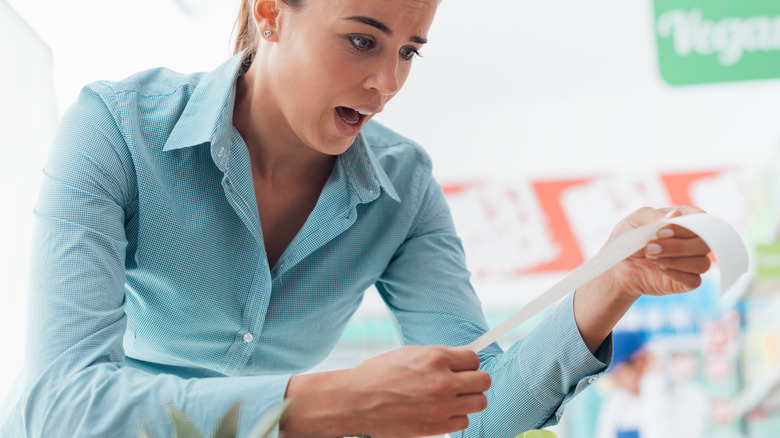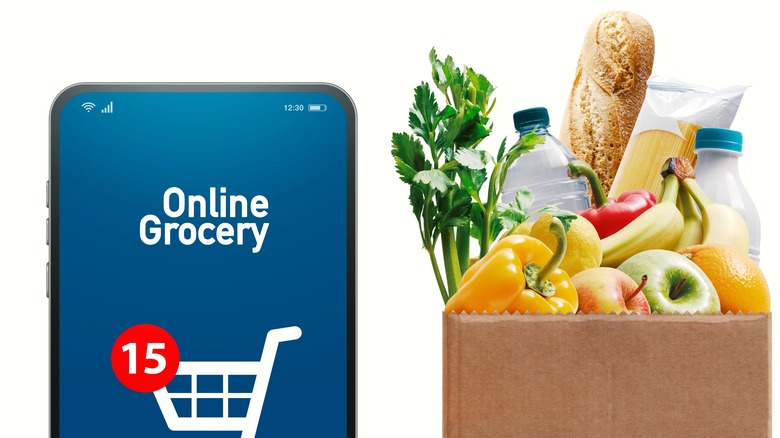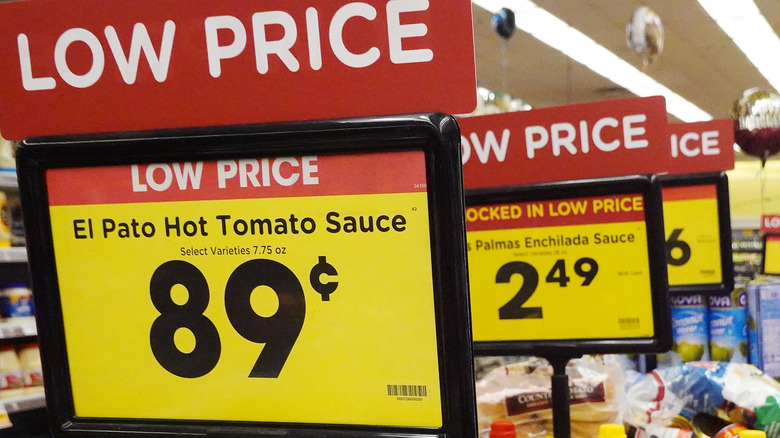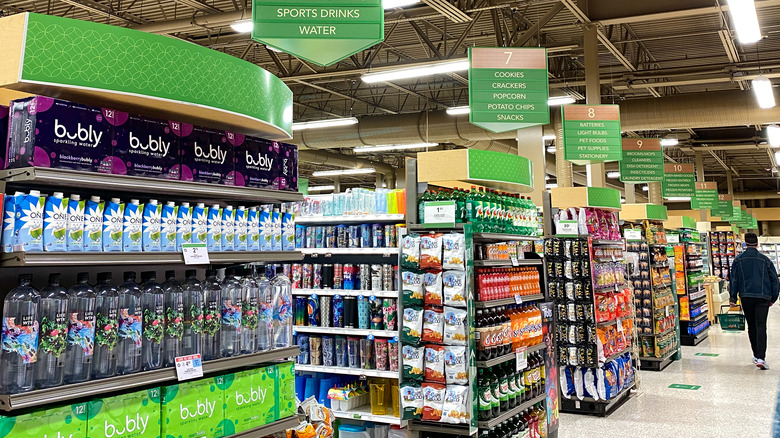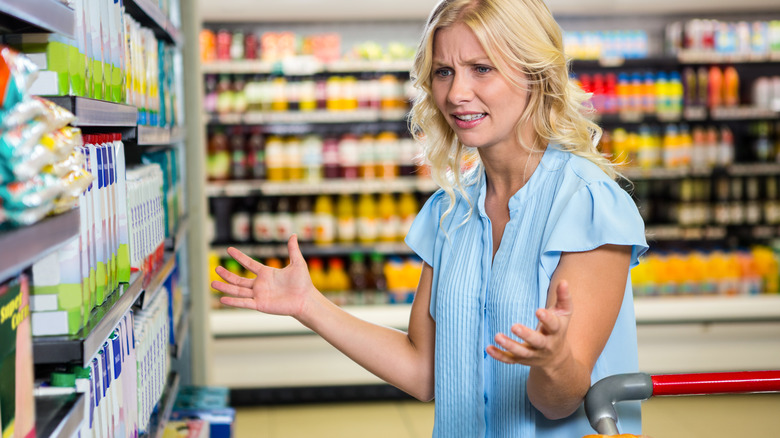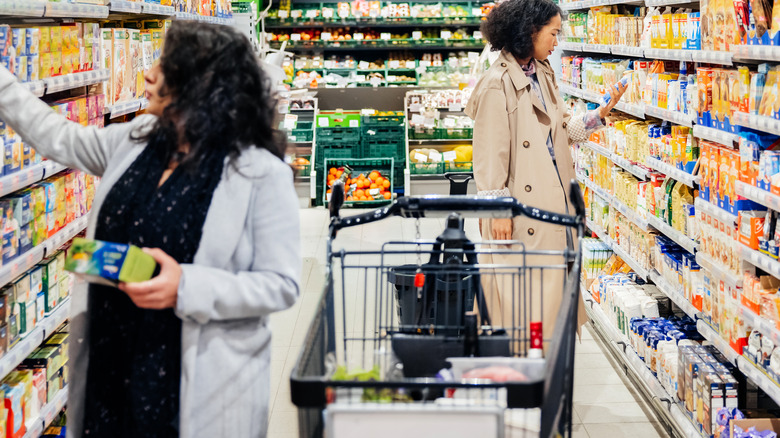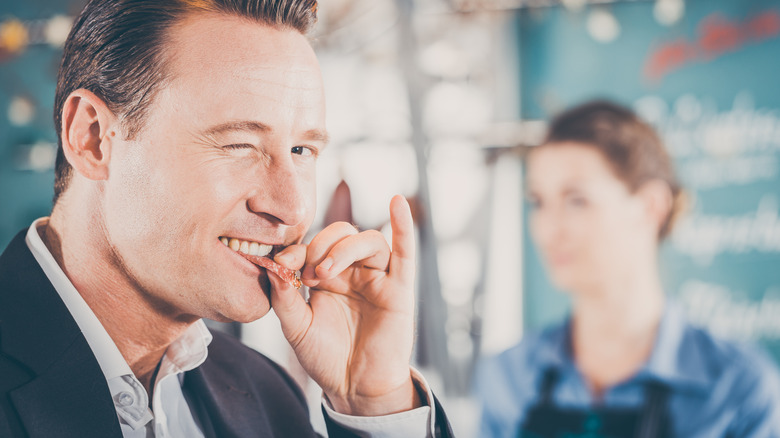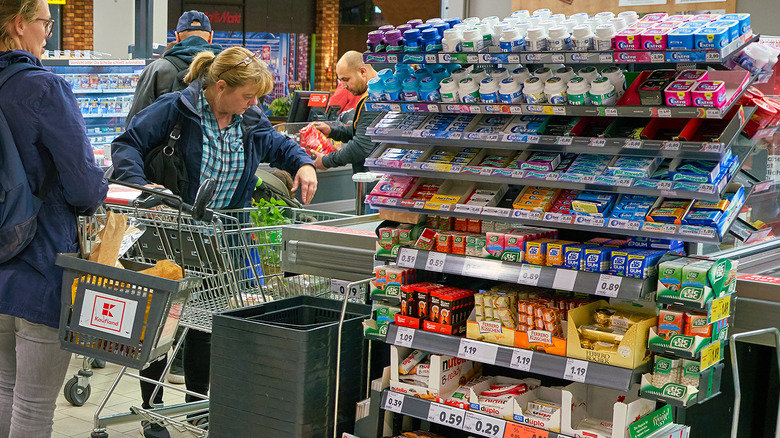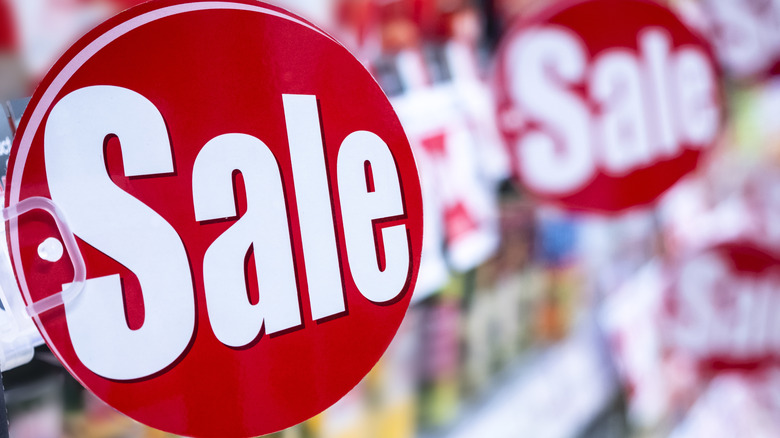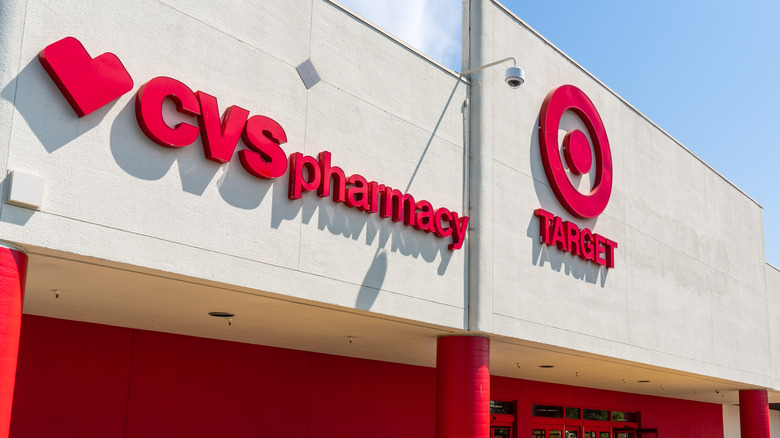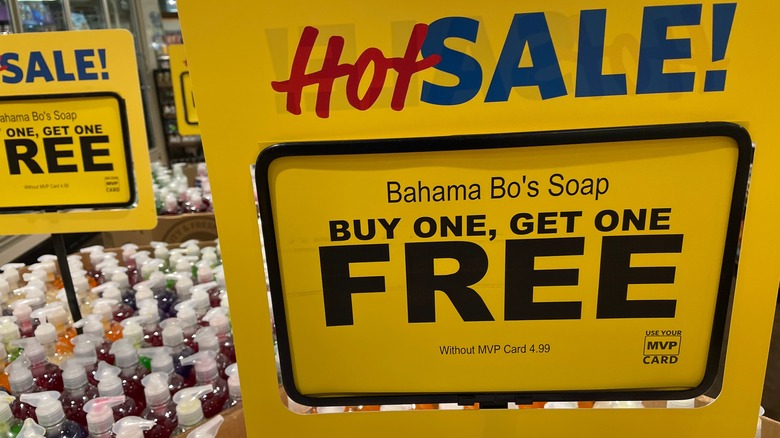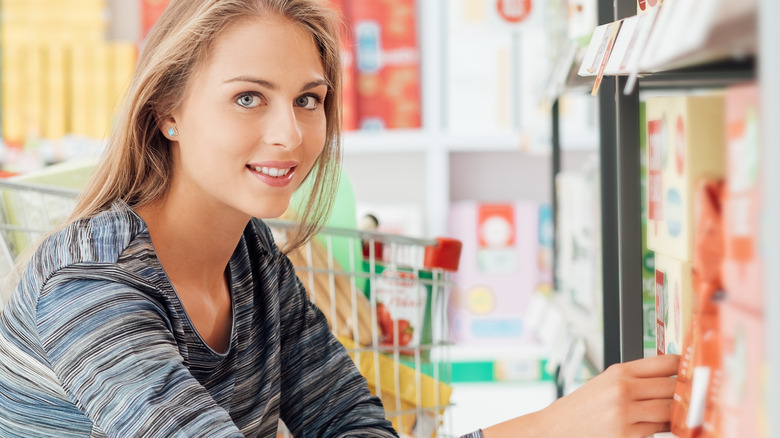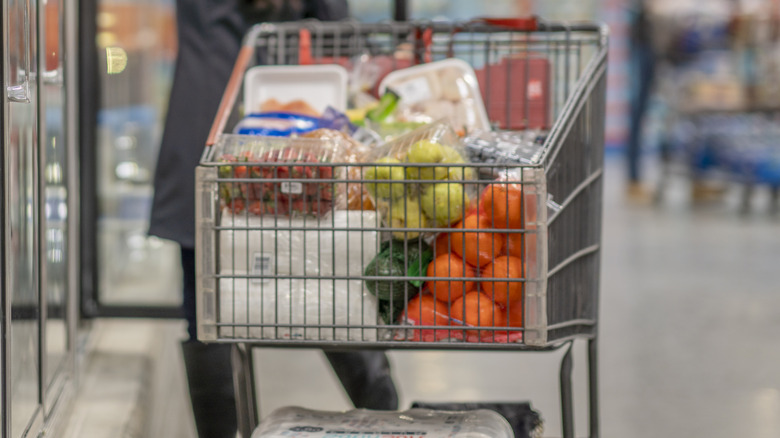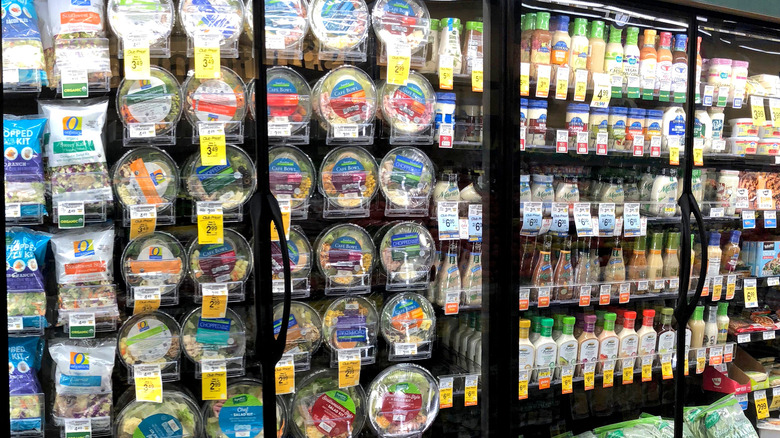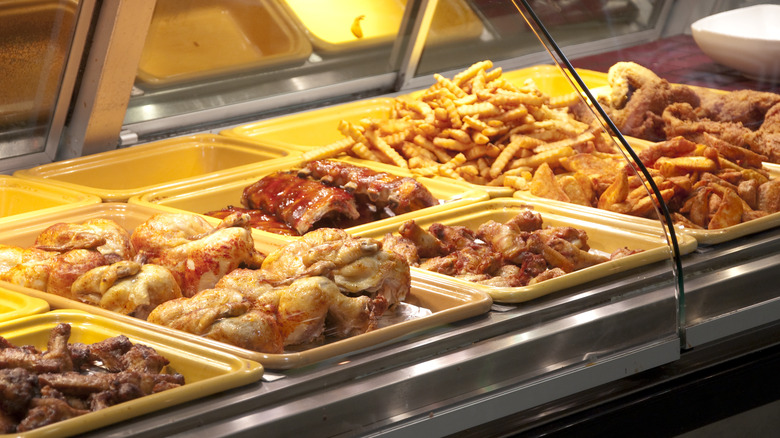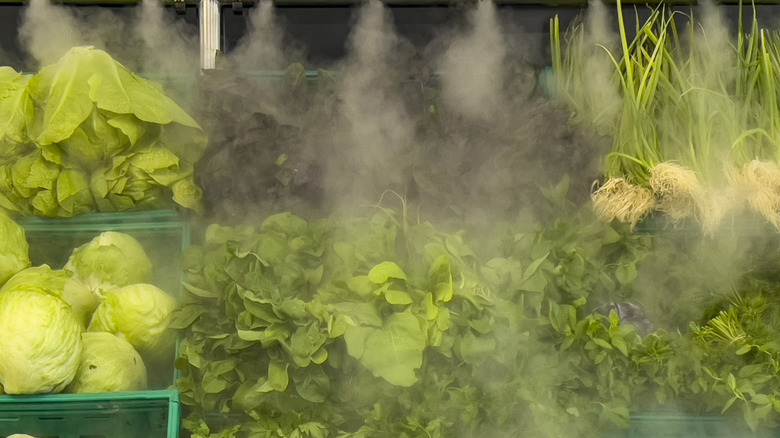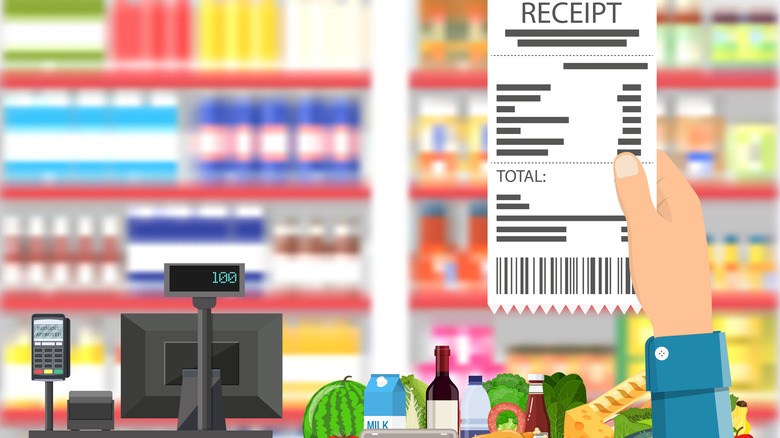17 Sneaky Ways Grocery Stores Trick You Into Spending Money
The price of food has increased a lot over the last few years, but is that the only reason your supermarket bill is as high as it is? Supermarkets are set up very intentionally to entice shoppers to spend a lot of money. It's true. Grocery stores are businesses, so it only makes sense for them to seek to encourage customers to buy as much as possible. That's how they make money.
So, the way-too-high tab on your grocery receipt might not all be inflation-related. It's entirely possible you could be falling for some supermarket tricks designed to encourage shoppers to spend without even realizing it. What can you do? Knowledge is power. Discover some of the sneaky ways supermarkets set out to trick you — and everyone else — into maximizing your spending. Once you know what they're up to, you can use your newfound knowledge to help rein in your grocery expenses.
Higher prices for online orders
Shopping online can be extremely convenient. But it could also be costing you money. If you shop at a store that overtly adds a convenience charge or delivery fee, then this could be obvious. However, not all stores are transparent about the charges that go along with online shopping. When you go into most grocery apps, or visit even supermarket websites, you'll be asked to specify whether you plan to shop in-store, for curbside pickup, or home delivery. With some stores (but not all), that's at least partially because prices aren't the same for each shopping method.
After hearing from a viewer who noticed a big discrepancy in online prices versus in-store, reporters at WABC-TV in Philadelphia, Pennsylvania decided to check things out for themselves and to share the results. They learned that some stores charge the same thing for online and in-store shopping, while others charge a higher price for online products. They found that some stores seem to mark up everything, while others seem to pick and choose which items are higher.
Making regular price displays look like there's a sale
The brightly colored signs adorning tables and shelves in the supermarket signal super savings in the form of deep discounts, don't they? Well, maybe they do, maybe they don't. Grocery stores have started setting up displays with what looks like sale signage but is not. Instead, these displays make you think you're seeing special pricing but, in reality, they're just calling your attention to an item being offered for sale at its regular price. You'll often find items set up to look like special deals on tables at the entrance of a store or on endcap displays.
Gone are the days of assuming that special supermarket signs signal a sale. If you don't see the product's regular price and its sale price posted on a sign along with an end date for the lower price, the item isn't discounted. The supermarket staff is hoping you perceive it is being on sale so you grab a few or — better yet — stock up with several. Is this a deceptive promotional strategy or just creative? You decide.
Forcing you to hike past overpriced endcaps to get to essentials
It's not an accident that milk and eggs are never set up just inside the entrance or in front of the checkout lines. They're in the back of the store for a reason. If you want milk and/or eggs, you're going to walk, and walk, and walk. The more end caps you walk by on your way to the items you came there to get, the more likely it is that you're going to snag things to add to your cart. It's that simple.
Supermarkets are strategically arranged so shoppers will have to walk past multiple endcap displays to get to basic staple items that people tend to purchase frequently, in order to get you to buy stuff you hadn't planned on purchasing. Even when endcaps don't have "fake sale" signs on them, they're still designed to inspire impulse purchases. They're usually filled with seasonal items or high-dollar brands of popular products. While you're getting in your steps on the way to snag some eggs and milk, be careful of what impulse items find their way into your cart.
Putting different kinds of essentials on opposite ends of the store
Not only do staple items tend to be at the back of the store, but store layouts are often set up so they're spread out pretty far away from each other. Sure, eggs and milk are usually fairly close together — but what about bread? That's usually on the complete other side of the store, as far from the dairy case as it can get. If you run into the store to purchase the key perishables you need to whip up a tasty breakfast (like eggs, milk, and bread), you're going to cover all of the square footage between the front and the back of the store as well as from side to side.
Chances are that you won't be able to escape a single endcap display in your quest to acquire these few simple items. There's no telling what might find its way into your cart. This is how many a box of sugary cereal finds its way into unsuspecting pantries. After all, as long as you make it to the milk you'll be able to get milk and cereal on the table even if you're exhausted from walking all over the store.
Frequently rearranging the aisles
Speaking of store layouts, they've become a bit of a moving target. These days, it seems that as soon as we figure out where everything is in our favorite store, the powers-that-be decide to rearrange everything. If you don't go into a certain store for a few weeks, you just might find that the entire place has been rearranged the next time you enter the premises. It's like they don't want you to know where the items you want to buy are located.
The truth is, that's exactly why they do it. If you know where everything is, you can walk into the store with a pre-planned route and snag everything on your shopping list without paying any attention to what else is there. But if nothing is where you remember it, you'll have to wander the aisle to look for what you need. And when you do that, you'll find all kinds of things to buy that weren't on your list. They'll find their way into your cart and, from there, onto your register receipt.
Slowing you down with narrow aisles
As if having to find your way around a recently rearranged grocery store isn't bad enough, it can also be challenging to navigate your way down the aisles around other shoppers. Have you ever wondered why supermarkets don't super-size their aisles? Sure, they need to pack as much product in per square foot as possible, but that's not the only reason. If the aisles were wide enough for shoppers to smoothly slide down each aisle, there would never be any traffic jams.
From your perspective, getting in and out of the store as quickly as possible would be a great thing. But that's not what the super-marketers behind grocery store marketing want. They want you to spend plenty of time in the aisles, and narrow aisles help make sure you do just that. After all, when you're stuck there waiting for other shoppers to clear the way, you've got to do something. And you'll browse the aisle. And that's when unplanned purchases will find their way into your cart. All because the aisle isn't quite wide enough for multi-lane shopping.
Cooking delicious-smelling samples right in the aisles
Just when you thought you found an empty aisle to roll right down, out of nowhere a sample table catches your eye. Depending on what they're sharing, you might even smell a selection of sizzling samples before you even see the tasting station. Surely you have to stop by and have a little nibble. It's such a treat to be treated to a free sample, but the reason that they're giving away free food right there in the grocery store aisle isn't that they know you're hungry after hiking up and down the aisle and across the store and back.
In-store sampling is a powerful strategy to get you to purchase something that you didn't plan to buy. After all, if it tastes good when you try it here, wouldn't it be just as yummy at home? And you wouldn't want to be rude to the person handing out the samples. Especially after they give you a coupon for a special discount. It's amazing how much sales spike on sampling days — by more than 650%, according to Supermarket News.
Putting pricy single-serve drinks and snacks by checkout lines
After all that hiking around and across the store, it's finally time to head out. Even if you noshed on some free sample nibbles while shopping, chances are that you've worked up a bit of an appetite. That's okay, though, because you've got a shopping cart full of food. But, depending on what you are purchasing, chances are that it'll require cooking or at least some prep before you can eat it. That's what makes the space next to the checkout line such prime real estate in a supermarket for individually packaged candy and similar snacks, as well as pre-chilled bottles of soda and other beverages.
With a shopping cart full of groceries and the cash register looming just ahead, it might be tough for a shopper to rationalize a 12-pack of drinks or a big bag of candy, but it's pretty easy to pick up a candy bar and a single can or bottle of a tasty drink to enjoy on the way home. That is the final upsell the supermarket has to offer (unless you also snag a magazine or two while you're in line).
Luring you in with loss leaders
Most grocery circulars have a few items advertised at prices so low that you'll go to the store just to get them, even if you don't need anything else or if they're at a store where you don't usually shop. Those items are called loss leaders. Think of them as items with uber-low prices carefully selected to lead consumers down a path of purchasing that might otherwise have been avoided.
Sure, loss leaders are a terrific bargain (assuming that they're things that you actually use and need). But do you ever really go into a store and purchase only what's on sale at rock-bottom prices? Supermarkets are banking on the fact that you probably won't. A store can take a little bit of a loss on a few items if that means shoppers are going to go ahead and pick up other stuff while they're in the store that just might be priced higher than you could get it for in other stores.
Putting stores inside of other stores for one-stop shopping
Where should you get your prescription filled? If you need to head to Super Target to pick up some groceries, it just makes sense to use CVS Pharmacy, because you'll find a CVS pharmacy inside the supermarket/mass merchandise store where you can get almost anything you need. Your store may also have a Starbucks, so you can enjoy a hot beverage while you stroll the aisles or wait for your prescription. What if you need to get a haircut or have your nails done while you're out stocking your pantry? Well, then, Walmart is your friend, as chances are that you'll find a hair salon and nail salon just inside the front entrance of the store.
Walmart and Target aren't the only retailers seeking to attract customers with the store-inside-a-store concept. Just like grocery stores expect that they can lure you in with loss leaders and you'll go ahead and do the rest of your shopping while you're there, the same is true with the store-within-a-store concept. If need a prescription filled and groceries, being able to do it all at the same place is so very convenient that you might just get in the habit of shopping there all the time rather than scanning circulars for the best deal.
Listing sale prices for multiples rather than single items
To a true bargain shopper, there's nothing quite as exhilarating as a buy one, get one (BOGO) free sale or a 10 for $10 special. But did you know that in some cases, you don't have to buy as many as advertised to get the same price? This isn't true of every grocery chain, and the rules may vary by location. For example, Publix stores in some states allow customers to purchase single quantities of BOGO items for 50% off the regular price.
The next time you're shopping and a little voice inside your head tells you that you don't need as many items as you're piling in your cart just to save a bit of cash, stop and think about it and ask if the store will honor the sale price for a lower quantity purchase. The store may still require you to purchase multiples to get the deal, but that's okay. Knowing whether you have the option to benefit from the sale with a smaller purchase or not will help you make an informed decision about whether the purchase makes sense for you, or if it's only really a good deal for the store.
Putting the least expensive brands on hard-to-reach shelves
Shelf positioning is a sneaky strategy that stores (and brands) use to make sure that customers see pricy items and those with high profit margins first. When you look at a supermarket shelf, the highest-end items will be in the center of the display, on the shelves that are at eye level for most shoppers. The lower-priced brands are above or below these front-and-center items. You'll have to reach up or down to find them, with the generic items generally being the ones that are the hardest to reach.
It's not just the store behind this strategy. Food manufacturers pay a premium to supermarket chains to get their items featured on the most visible and easiest-to-reach shelves in the store. You can call this a sneaky strategy, but it's really not. It's right there in front of you, at eye level, every time you walk into a supermarket. If you want to find bargains in the aisles, be willing to bend and stretch to get to them.
Providing giant shopping carts
Most grocery stores have one size of shopping cart these days, and that is huge. That's because if you have an empty cart, chances are that you're probably going to put quite a bit of stuff in it while you're shopping, even if there's not a lot on your list. If the store made a smaller cart available to you, it would be much easier to curb your impulse purchases because you might quickly fill up the whole thing with the items on your shopping list with no space to spare for unplanned purchases.
With the massive size of most supermarket carts, though, there's usually room for quite a few impulse purchases to be added along the way — and that's what the supermarket wants. Large shopping carts can also help disguise how much stuff you've put in your cart until you're already checking out and it's all but too late to do anything about it.
Displaying items that pair well side by side
Just like supermarkets will strategically space out basic staples and make you work to get to all of them, they also decide which items to pair together very carefully. For example, consider how people purchase salad. In the produce section, you can purchase separate salad ingredients to wash and cut up yourself, or you can buy bags of pre-cut salad greens or even salads that are fully put together.
Bagged salad isn't the cheapest option, but it is very convenient. When you reach into the supermarket case to pick up a pre-cut salad mix, you're sure to find a selection of the store's finest (and most expensive) salad dressing within easy reach. This is a perfect illustration of how supermarkets will strategically display items that pair well side by side to encourage additional purchases. Someone looking for the most convenient salad option is likely to also enjoy the convenience of having dressing right there, rather than having to hike across the store to find lower-priced salad dressing.
Prepared foods that are much pricier than the sum of their ingredients
The prepared foods section is another strategy that supermarkets use to capitalize on the fact that grocery shopping can be exhausting and that shoppers often work up an appetite. It's happened to all of us — we're so tired from shopping that we decide to pop by the hot food counter or the deli before heading to the cash register to pick up something for dinner so we don't have to cook when we get home.
Everything that a supermarket sells in an already-prepared form is made of ingredients available to purchase in the store, for a premium price that's much higher than buying the components and making it yourself. Supermarkets are counting on that — at least some of the time — you'll care more about the convenience of a ready-made meal than calculating the cost of the components. Better yet, they want you to stop by and snag something else that's already prepared the next time you head to a potluck dinner or an "everyone brings a dish" party.
Spraying fresh produce with mist
Have you ever noticed how much better fresh veggies look in the produce section of the supermarket than they do after you bring them home? When you see it in the store, it looks well worth the cost, but by the time you get it home or it has sat in your fridge for just a very short time, it looks like the past-its-prime produce you passed by in the discount bin.
Just how do grocery stores keep their produce looking so appealing? Their secret strategy is to regularly spray it with mist. That's their secret weapon to keep pretty much everything in the produce aisle looking as fresh and appealing as possible. After all, savvy customers wouldn't pay a premium price for sad-looking produce. They want it to look its best so that it'll sell at full price rather than having to market it as reduced for quick sale.
How to spend less at the supermarket
Surprised by some of these sneaky strategies? Hey, now you know, and knowledge is power. Now that you're aware of some of the less than overt techniques grocery stores use to encourage you to spend, spend, spend, you can mark yourself safe from their sneaky ways and save on your grocery bill. It'll be easier to stick to your shopping list when you're wise to the store's strategies.
From recognizing pseudo sales to stubbornly sticking to your shopping list, it is within your power to keep your spending under control. You'll never again have to fall for efforts to trick you into buying the most expensive brands simply because they're the first ones you see, and you can cut down on last-minute snacks or readymade meals by putting dinner in your slow cooker to simmer before you head to the store. When you know you have hot food waiting at home, it'll be oh-so-easy to resist temptation in the store.
